Abstract
The ability of certain azole substituted oligodeoxy-ribonucleotides to promote antiparallel triple helix formation with duplex targets having CG or TA interruptions in the otherwise homopurine sequence was examined. 2'-Deoxyribonucleosides of the azoles, which include pyrazole, imidazole, 1,2,4-triazole and 1,2,3,4-tetrazole were synthesized using the stereo-specific sodium salt glycosylation procedure. These nucleosides were successfully incorporated using solid-support, phosphoramidite chemistry, into oligonucleotides designed to interact with the non-homopurine duplex targets. The interaction of these modified oligonucleotides with all four possible base pairs was evaluated and compared to similar data for a series of natural oligonucleotides. The oligonucleotides containing simple azoles enhanced the triplex forming ability considerably at non-homopurine targets. Binding of these modified oligonucleotides to duplex targets containing TA inversion sites was particularly noteworthy, and compare favorably to unmodified oligonucleotides for binding to duplex targets containing CG as well as TA base pairs. The selectivity exhibited by certain azoles is suggestive of base pair specific interactions. Thus, the azoles evaluated during this study show considerable promise for efforts to develop generalized triplex formation at non-homopurine duplex sequences.
Full text
PDF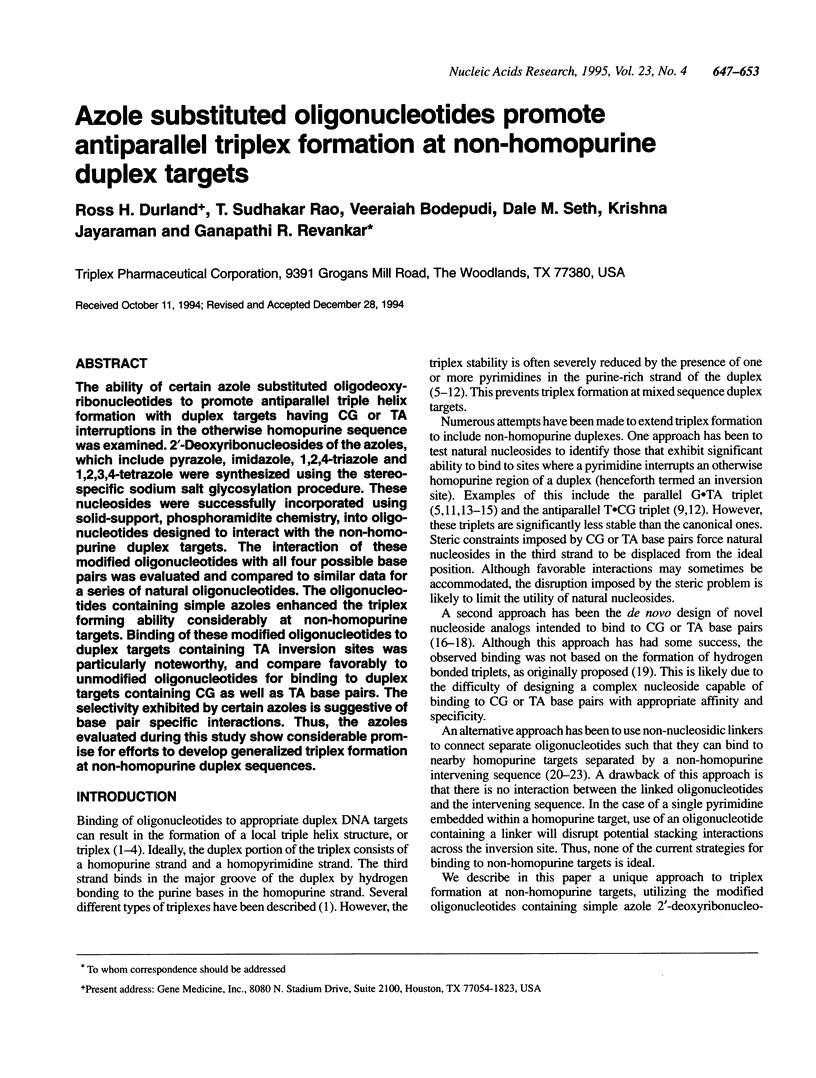
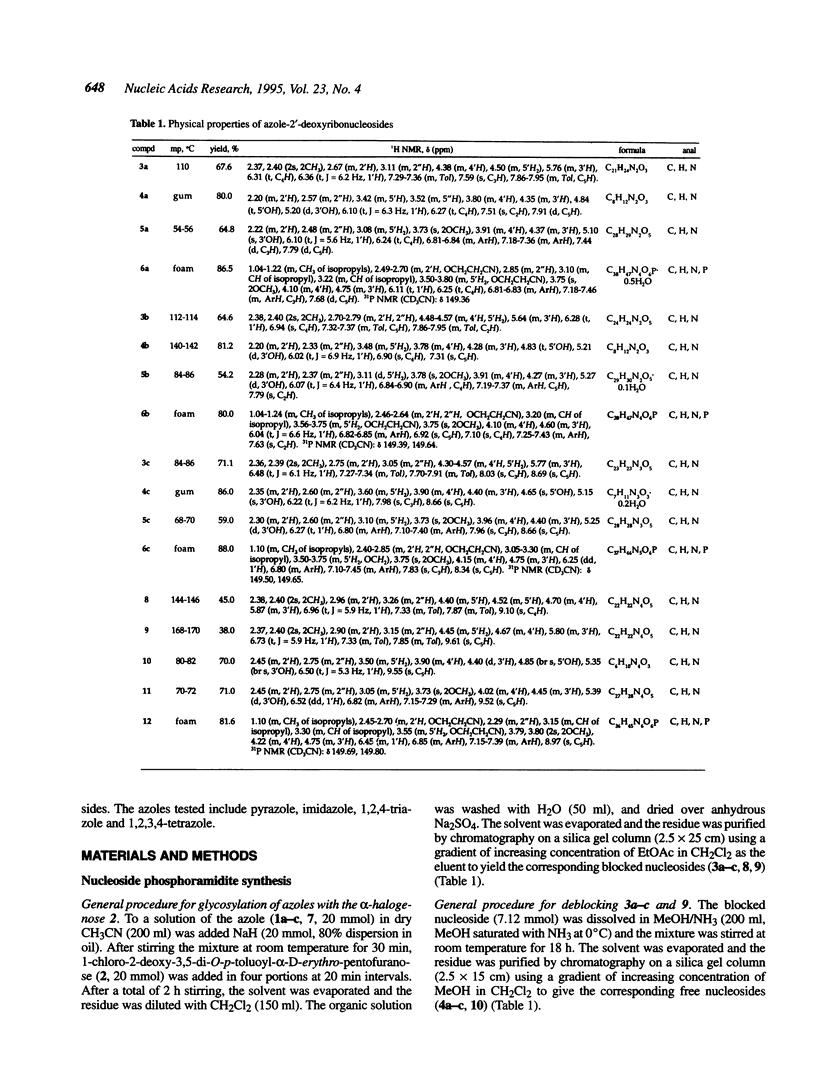
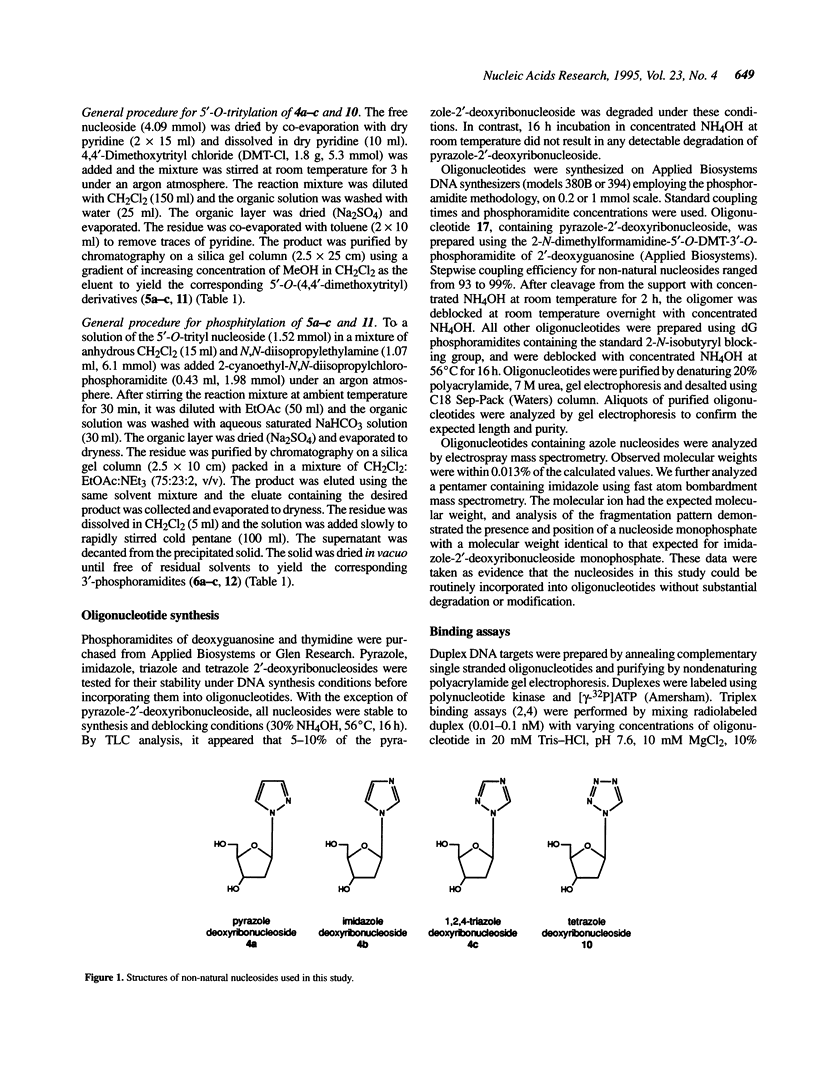
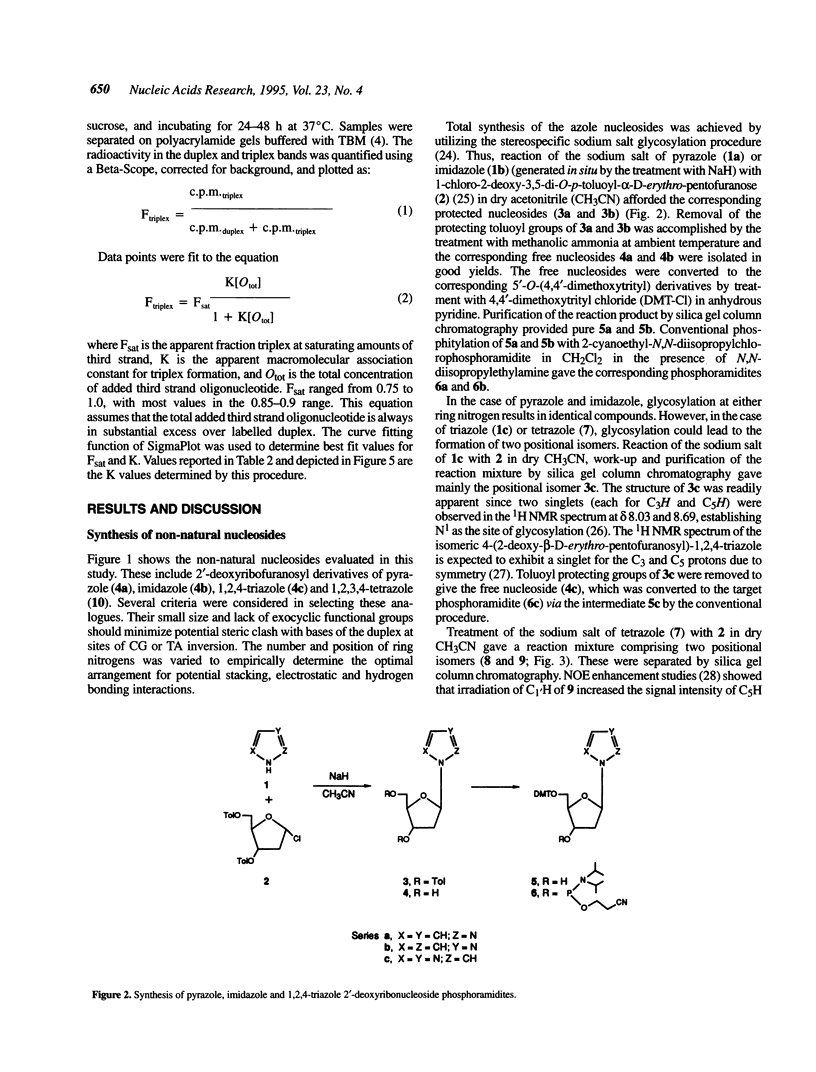
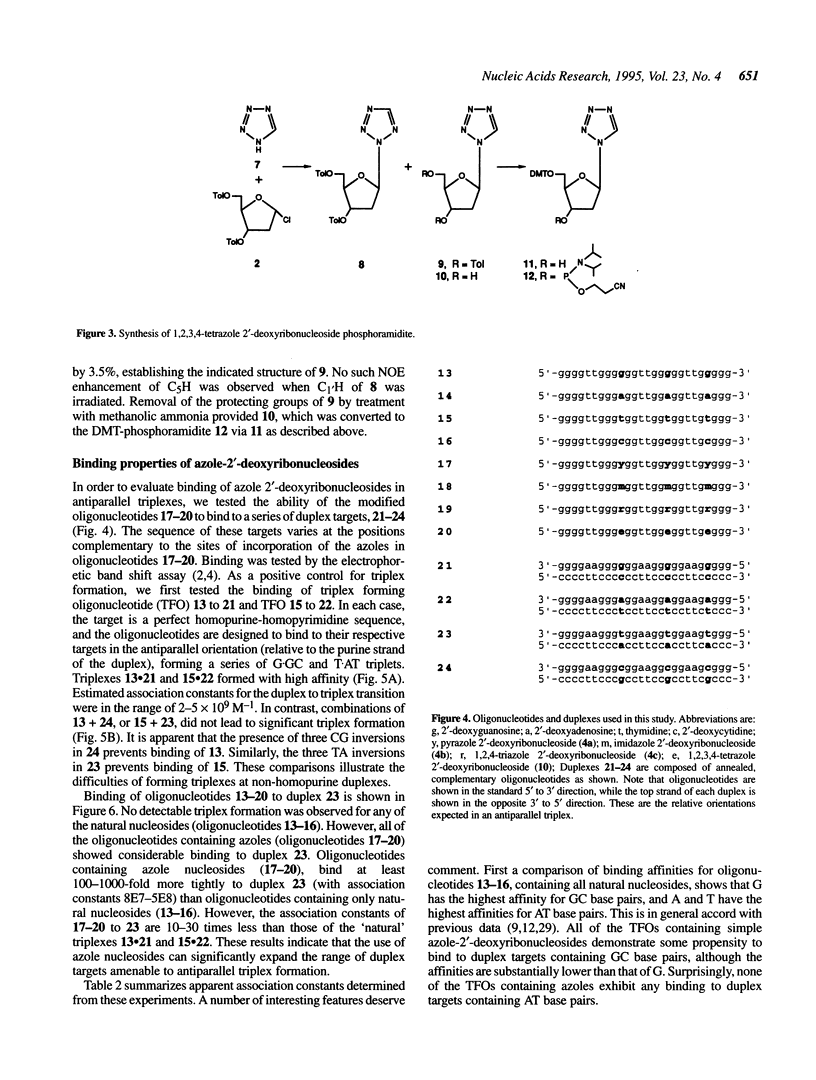
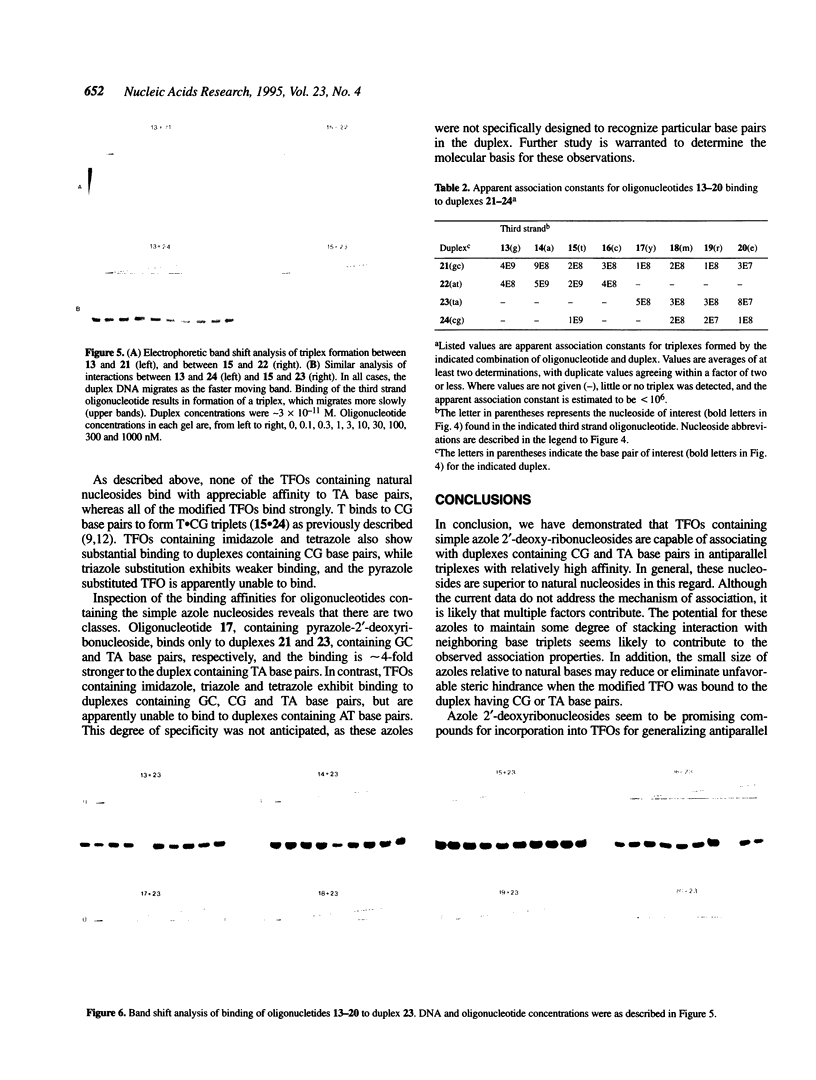
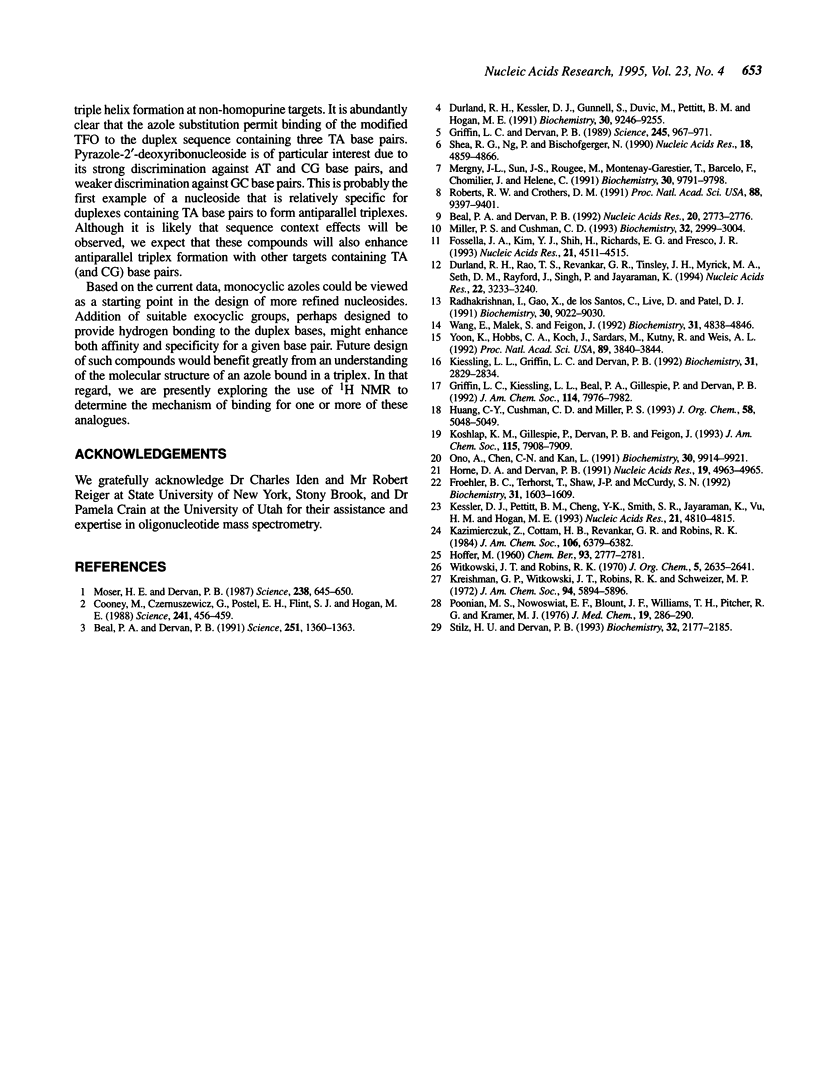
Images in this article
Selected References
These references are in PubMed. This may not be the complete list of references from this article.
- Beal P. A., Dervan P. B. Second structural motif for recognition of DNA by oligonucleotide-directed triple-helix formation. Science. 1991 Mar 15;251(4999):1360–1363. doi: 10.1126/science.2003222. [DOI] [PubMed] [Google Scholar]
- Beal P. A., Dervan P. B. The influence of single base triplet changes on the stability of a pur.pur.pyr triple helix determined by affinity cleaving. Nucleic Acids Res. 1992 Jun 11;20(11):2773–2776. doi: 10.1093/nar/20.11.2773. [DOI] [PMC free article] [PubMed] [Google Scholar]
- Cooney M., Czernuszewicz G., Postel E. H., Flint S. J., Hogan M. E. Site-specific oligonucleotide binding represses transcription of the human c-myc gene in vitro. Science. 1988 Jul 22;241(4864):456–459. doi: 10.1126/science.3293213. [DOI] [PubMed] [Google Scholar]
- Durland R. H., Kessler D. J., Gunnell S., Duvic M., Pettitt B. M., Hogan M. E. Binding of triple helix forming oligonucleotides to sites in gene promoters. Biochemistry. 1991 Sep 24;30(38):9246–9255. doi: 10.1021/bi00102a017. [DOI] [PubMed] [Google Scholar]
- Durland R. H., Rao T. S., Revankar G. R., Tinsley J. H., Myrick M. A., Seth D. M., Rayford J., Singh P., Jayaraman K. Binding of T and T analogs to CG base pairs in antiparallel triplexes. Nucleic Acids Res. 1994 Aug 11;22(15):3233–3240. doi: 10.1093/nar/22.15.3233. [DOI] [PMC free article] [PubMed] [Google Scholar]
- Fossella J. A., Kim Y. J., Shih H., Richards E. G., Fresco J. R. Relative specificities in binding of Watson-Crick base pairs by third strand residues in a DNA pyrimidine triplex motif. Nucleic Acids Res. 1993 Sep 25;21(19):4511–4515. doi: 10.1093/nar/21.19.4511. [DOI] [PMC free article] [PubMed] [Google Scholar]
- Froehler B. C., Terhorst T., Shaw J. P., McCurdy S. N. Triple-helix formation and cooperative binding by oligodeoxynucleotides with a 3'-3' internucleotide junction. Biochemistry. 1992 Feb 18;31(6):1603–1609. doi: 10.1021/bi00121a004. [DOI] [PubMed] [Google Scholar]
- Griffin L. C., Dervan P. B. Recognition of thymine adenine.base pairs by guanine in a pyrimidine triple helix motif. Science. 1989 Sep 1;245(4921):967–971. doi: 10.1126/science.2549639. [DOI] [PubMed] [Google Scholar]
- Horne D. A., Dervan P. B. Effects of an abasic site on triple helix formation characterized by affinity cleaving. Nucleic Acids Res. 1991 Sep 25;19(18):4963–4965. doi: 10.1093/nar/19.18.4963. [DOI] [PMC free article] [PubMed] [Google Scholar]
- Kessler D. J., Pettitt B. M., Cheng Y. K., Smith S. R., Jayaraman K., Vu H. M., Hogan M. E. Triple helix formation at distant sites: hybrid oligonucleotides containing a polymeric linker. Nucleic Acids Res. 1993 Oct 11;21(20):4810–4815. doi: 10.1093/nar/21.20.4810. [DOI] [PMC free article] [PubMed] [Google Scholar]
- Kiessling L. L., Griffin L. C., Dervan P. B. Flanking sequence effects within the pyrimidine triple-helix motif characterized by affinity cleaving. Biochemistry. 1992 Mar 17;31(10):2829–2834. doi: 10.1021/bi00125a026. [DOI] [PubMed] [Google Scholar]
- Kreishman G. P., Witkowski J. T., Robins R. K., Schweizer M. P. The use of proton and carbon-13 nuclear magnetic resonance for assignment of the glycosylation site in 3- and 5-substituted 1- -D-ribofuranosyl-1,2,4-triazoles. J Am Chem Soc. 1972 Aug 9;94(16):5894–5896. doi: 10.1021/ja00771a060. [DOI] [PubMed] [Google Scholar]
- Mergny J. L., Sun J. S., Rougée M., Montenay-Garestier T., Barcelo F., Chomilier J., Hélène C. Sequence specificity in triple-helix formation: experimental and theoretical studies of the effect of mismatches on triplex stability. Biochemistry. 1991 Oct 8;30(40):9791–9798. doi: 10.1021/bi00104a031. [DOI] [PubMed] [Google Scholar]
- Miller P. S., Cushman C. D. Triplex formation by oligodeoxyribonucleotides involving the formation of X.U.A triads. Biochemistry. 1993 Mar 30;32(12):2999–3004. doi: 10.1021/bi00063a010. [DOI] [PubMed] [Google Scholar]
- Moser H. E., Dervan P. B. Sequence-specific cleavage of double helical DNA by triple helix formation. Science. 1987 Oct 30;238(4827):645–650. doi: 10.1126/science.3118463. [DOI] [PubMed] [Google Scholar]
- Ono A., Chen C. N., Kan L. S. DNA triplex formation of oligonucleotide analogues consisting of linker groups and octamer segments that have opposite sugar-phosphate backbone polarities. Biochemistry. 1991 Oct 15;30(41):9914–9912. doi: 10.1021/bi00105a015. [DOI] [PubMed] [Google Scholar]
- Poonian M. S., Nowoswiat E. F., Blount J. F., Williams T. H., Pitcher R. G., Kramer M. J. Synthesis of tetrazole ribonucleosides and their evaluation as antiviral agents. J Med Chem. 1976 Feb;19(2):286–290. doi: 10.1021/jm00224a016. [DOI] [PubMed] [Google Scholar]
- Radhakrishnan I., Gao X., de los Santos C., Live D., Patel D. J. NMR structural studies of intramolecular (Y+)n.(R+)n(Y-)nDNA triplexes in solution: imino and amino proton and nitrogen markers of G.TA base triple formation. Biochemistry. 1991 Sep 17;30(37):9022–9030. doi: 10.1021/bi00101a016. [DOI] [PubMed] [Google Scholar]
- Roberts R. W., Crothers D. M. Specificity and stringency in DNA triplex formation. Proc Natl Acad Sci U S A. 1991 Nov 1;88(21):9397–9401. doi: 10.1073/pnas.88.21.9397. [DOI] [PMC free article] [PubMed] [Google Scholar]
- Shea R. G., Ng P., Bischofberger N. Thermal denaturation profiles and gel mobility shift analysis of oligodeoxynucleotide triplexes. Nucleic Acids Res. 1990 Aug 25;18(16):4859–4866. doi: 10.1093/nar/18.16.4859. [DOI] [PMC free article] [PubMed] [Google Scholar]
- Stilz H. U., Dervan P. B. Specific recognition of CG base pairs by 2-deoxynebularine within the purine.purine.pyrimidine triple-helix motif. Biochemistry. 1993 Mar 9;32(9):2177–2185. doi: 10.1021/bi00060a008. [DOI] [PubMed] [Google Scholar]
- Wang E., Malek S., Feigon J. Structure of a G.T.A triplet in an intramolecular DNA triplex. Biochemistry. 1992 May 26;31(20):4838–4846. doi: 10.1021/bi00135a015. [DOI] [PubMed] [Google Scholar]
- Witkowski J. T., Robins R. K. The chemical synthesis of the 1,2,4-triazole nucleosides related to uridine,2'-deoxyuridine, thymidine, and cytidine. J Org Chem. 1970 Aug;35(8):2635–2641. doi: 10.1021/jo00833a033. [DOI] [PubMed] [Google Scholar]
- Yoon K., Hobbs C. A., Koch J., Sardaro M., Kutny R., Weis A. L. Elucidation of the sequence-specific third-strand recognition of four Watson-Crick base pairs in a pyrimidine triple-helix motif: T.AT, C.GC, T.CG, and G.TA. Proc Natl Acad Sci U S A. 1992 May 1;89(9):3840–3844. doi: 10.1073/pnas.89.9.3840. [DOI] [PMC free article] [PubMed] [Google Scholar]




